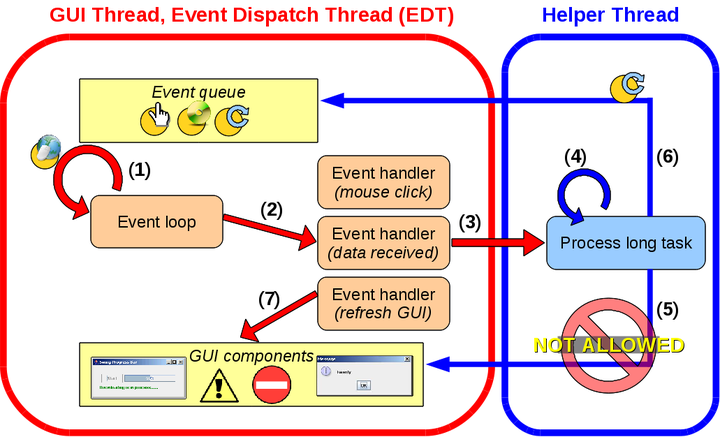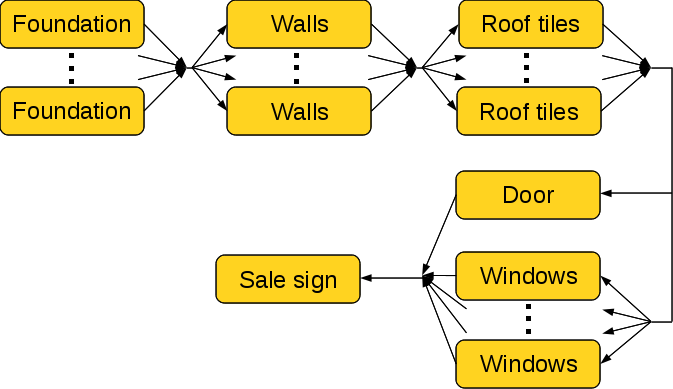Parallel Task - Quick Start
Here you will find background information motivating Parallel Task (short ParaTask), as well as some examples to illustrate the numerous features it provides.
Contents
1 Motivation
1.1 Why multi-threading?
1.2 Graphical user interfaces
2 Parallel Task
2.1 Model overview
2.2 Example 1: Hello, World!
2.3 Example 2: Let's get surfing!
2.4 Example 3: Building a house (GUI)
3 Known Issues
3.1 Eclipse 3.8 (Remote Linux)
1. Motivation and Background
1.1 Why multi-threading?
There are two reasons why programmers may wish to multi-thread their desktop applications: to improve performance, and to improve responsiveness. ParaTask allows programmers to easily achieve both these goals.
Improving
performance
Parallel
computing has arrived to mainstream desktop systems in the form of
multi-core processors because of the difficulties in maintaining
improvements in uni-processor clock-speed. Unfortunately, users will
not automatically witness any performance improvements unless their
applications are
parallelised. Parallel computing is however notoriously difficult,
especially in terms of program correctness and high performance.
Improving
responsiveness
Multi-threading, however, is also necessary even when desktop
applications are to be run on a uni-processor. How many times have you
experienced unresponsive applications where buttons don't respond
no matter how many times you click? Then you drag the application
window around and it stays grey until it finishes its current job? Such
frustrating applications are not multi-threaded: there is only one
thread doing all the work.
1.2 Graphical user interfaces

An important aspect of these applications is the event loop, waiting for events to arrive (1). The events are then dispatched to the appropriate event handler to take the appropriate action (2). Many toolkits are available for programmers to ease the development of these event-based applications. The toolkits provide many graphical components as well as the event loop and event handling. Generally, programmers only need to specify the logic of event handlers (e.g. the response to a certain button being clicked).
Programmers must ensure that these event handlers are short so that control returns to the event loop. Otherwise, events will backlog and the application appears unresponsive (for example, GUI applications appear to “freeze” when the GUI does not refresh). For this reason, all time-consuming tasks must be dispatched to a helper thread (3) to allow the GUI thread to return to the event loop (1) to respond to other events. In the meantime, the helper thread executes the computation (4). Notice that the purpose of multi-threading so far has been solely to improve the application's responsiveness (rather than improve performance through parallelism).
In developing multi-threaded applications to improve performance and/or responsiveness, programmers must adhere to the above rules. ParaTask allows programmers to develop interactive and performant multi-threaded applications by simplifying the parallel development process.
2. Parallel Task
2.1 Model overview
2.2 Example 1: Hello, World!
public static void hello(String name) {
System.out.println("Hello from "+name);
}
TASK public static void task_hello() {
hello("Task");
}
TASK(*) public static void multi_hello() {
hello("Multi-Task [subtask "+CurrentTask.relativeID()+"]");
}
IO_TASK public static void interactive_hello() {
hello("I/O Task");
}
The first thing you'll notice is an excellent example of code reuse; here, these methods reuse the sequential code by calling hello(). The second thing to notice is that these 3 methods are almost identical; the only difference is the slight change in the TASK modifier. Now it is time to invoke these methods!
System.out.println("(1)");
hello("Sequential");
System.out.println("(2)");
TaskID id1 = task_hello();
System.out.println("(3)");
TaskIDGroup id2 = multi_hello();
System.out.println("(4)");
TaskID id3 = interactive_hello();
System.out.println("(5)");
Recall that hello() is a standard sequential method. The 3 task methods however have been annotated with a variant of the TASK keyword. Consequently, these 3 methods will now return a TaskID corresponding to a respective invocation of that task. Since execution of a task is asynchronous to it's caller, we need to synchronise with the task completion. One approach is to place the TaskIDs of these tasks inside a group and wait for the group to finish:
TaskIDGroup g = new TaskIDGroup(3);
g.add(id1);
g.add(id2);
g.add(id3);
System.out.println("** Going to wait for the tasks...");
g.waitTillFinished();
System.out.println("** Done! All tasks have now completed.");
Here is one possible output produced by this program:
Hello from Sequential
(2)
(3)
Hello from Task
(4)
(5)
** Going to wait for the tasks to execute...
Hello from I/O Task
Hello from Multi-Task [subtask 0]
Hello from Multi-Task [subtask 1]
** Done! All tasks have now completed.
The important thing to notice is how the tasks executed asynchronously with their caller. This is obvious since the statement following the task's invocation (i.e. "(2)", .. "(5)") were all executed before the actual task computation of the respective task.
From this example, it may seem unclear what the difference is between I/O and one-off tasks. This is because the difference between the 2 did not have an effect in this particular example (but will be illustrated in the following example). The difference with the multi-task is more obvious: the task is executed multiple times.
2.3 Example 2: Let's get surfing!
...
// count number of links
...
// print the time for this computation
...
}
First, we create a collection to store all the addresses we wish to access:
...
urls.add("http://en.wikipedia.org/wiki/Tongariro_National_Park");
Sequential:
Below is the sequential code:
webAccess(s);
}
System.out.println("Total time: "+time+" seconds.");
509 links for 'Auckland' [0.415 seconds, thread 1]
202 links for 'Rotorua' [0.209 seconds, thread 1]
127 links for 'Milford_Sound' [0.21 seconds, thread 1]
524 links for 'Christchurch' [0.613 seconds, thread 1]
467 links for 'Dunedin' [1.971 seconds, thread 1]
152 links for 'Queenstown,_New_Zealand' [0.402 seconds, thread 1]
149 links for 'Tongariro_National_Park' [0.407 seconds, thread 1]
Total time: 16.159 seconds.
One-off tasks:
The first step involves defining the task. To promote code-reuse, we implement this as a wrapper around the sequential method since webAccess() is thread-safe independent code:
webAccess(address);
}
for(String s: urls) {
TaskID id = webAccessTask(s);
g.add(id);
}
g.waitTillFinished();
System.out.println("Total time: "+time+" seconds.");
202 links for 'Rotorua' [0.415 seconds, thread 7]
830 links for 'New_Zealand' [3.106 seconds, thread 8]
127 links for 'Milford_Sound' [0.21 seconds, thread 7]
524 links for 'Christchurch' [1.804 seconds, thread 8]
152 links for 'Queenstown,_New_Zealand' [2.024 seconds, thread 8]
467 links for 'Dunedin' [1.569 seconds, thread 7]
149 links for 'Tongariro_National_Park' [0.203 seconds, thread 7]
Total time: 6.994 seconds.
Again, the actual individual times are not important. What we are interested in now is that the tasks were executed by a team of 2 worker threads (thread 7 and thread 8). As a result, the total time is a sum of the longest sum of times that one of the worker threads encounters. In this case, the 3 tasks executed by thread 8 took a total of 6.9 seconds.
For most computations, one-off tasks will be the right solution. But in this particular application, one-off tasks are probably not the best solution. Even though one-off tasks have allowed us to reduce the total time (since multiple worker threads are sharing the workload), we notice that webAccess() is not compute-intensive. The better solution would be I/O tasks (see below)!
Multi-tasks:
Multi-tasks are essentially one-off tasks, except they are executed multiple times! In particular, multi-tasks are still shared amongst a fixed number of worker threads. Below is a multi-task solution:
while ((s = queue.poll()) != null)
webAccess(s);
}
The difference here is that the entire collection is passed to the multi-task. Since this task is executed multiple times, each subtask will remove (from the concurrent collection) a url to access. The advantage of multi-tasks is that subtasks are automatically placed in a group and subtasks have group awareness (e.g. they could use a barrier, or inquire about their relative position within the group, etc). Executing the multi-task is easy:
TaskIDGroup g = webAccessMulti(urls);
g.waitTillFinished();
System.out.println("Total time: "+time+" seconds.");
In this application, the output from a multi-task would be the same as the one-off tasks above. This is because one-off tasks and multi-tasks are eventually all executed on a fixed number of worker threads. However, multi-tasks generally simplify the writing of data-parallel code (e.g. in this case, a TaskIDGroup is automatically returned containing all the individual TaskIDs).
I/O tasks:
Although one-off tasks will be the most common and useful in ParaTask, they are not ideal for this particular example. This is because webAccess() is not compute-intensive. As such, the worker threads spend a lot of time waiting for result from the network. This is where I/O tasks are best suited: for computations that involve external input/output.
IO_TASK public static void webAccessInteractiveTask(String address) {
webAccess(address);
}
I/O tasks are invoked exactly like the one-off tasks above, except that the tasks are not queued to be shared by the existing threadpool. Instead, each of the tasks is mapped to its own thread. This is the behaviour we desire, since these computations are not compute intensive, we prefer to have extra threads if it means the tasks are truly all executed concurrently. Having this distinction of I/O tasks will also help other compute-intensive tasks, since the worker threads will remain busy executing (as opposed to blocking waiting for input/output). Here is the result:
149 links for 'Tongariro_National_Park' [1.26 seconds, thread 17]
152 links for 'Queenstown,_New_Zealand' [1.263 seconds, thread 16]
202 links for 'Rotorua' [1.437 seconds, thread 11]
524 links for 'Christchurch' [1.694 seconds, thread 14]
467 links for 'Dunedin' [1.734 seconds, thread 15]
509 links for 'Auckland' [1.917 seconds, thread 10]
830 links for 'New_Zealand' [2.134 seconds, thread 9]
Total time: 2.16 seconds.
Notice how each of the tasks was executed by a different thread. Therefore, the total time is essentially the time of the longest task.
2.4 Example 3: Building a house (GUI)
On the left side, the user is able to select a colour for the roof and walls of a house being built. The "build" button actually builds the house, and the user is able to "clear" the screen to delete the graphic. At the bottom of the window, the user is able to switch the application mode (parallel mode or sequential mode). If the house is built too quickly,select a higher level of computation from the menu. When running the application in sequential mode, you will notice how it freezes and cannot select any of the GUI components. In the parallel mode however, the graphics even updates as the house updates for a much more appealing user experience.
Now we are ready to have a look at the interesting parts of this application, and see where ParaTask helps. When the user presses the build button, the application decides on the current mode. If the current mode is sequential, then the following code is executed:
Build.this.finishedBuilding();
The finishedBuilding() method refers to computations that will update the GUI after the house is built. If the current mode is parallel, then the following code is executed:
notify(Build.this::finishedBuilding());
You will notice that the parallel code using ParaTask is very similar to the sequential code. One difference, of course, is that the buildTask() method called is a TASK rather than a standard sequential method. Because of the asynchronous nature of tasks, we need a way to specify that the finishedBuilding() method be invoked after the task completes. More specifically, the finishedBuilding() method must be invoked by the GUI thread (i.e. Java's event dispatch thread). This is what the notify clause assures. We specify that the finishedBuilding() method is to be executed by the same thread that enqueued the task (in this case, it is the EDT since we are inside the actionPerformed() method). This is what allows the EDT to return to the event loop and maintain a responsive application.
Nested parallelism and dependences
When the application is run in parallel mode, you will notice the house is being built in parallel (when using a multi-core system). From the above code, it seems we only have one task (buildTask()). In actual fact, the buildTask() task creates further tasks and waits for them to complete. However, these smaller parts of the house need to be developed using a particular order. Here is the relationship between these tasks:

Tile t = null;
while ((t = tiles.poll()) != null) {
buildTile(t);
}
}
TASK(*) public void buildWalls(ConcurrentLinkedQueue sidings) {...}
TASK(*) public void buildRoofTiles(ConcurrentLinkedQueue tiles) {...}
TASK public void buildDoor(Door d) {...}
TASK(*) public void buildWindows(ConcurrentLinkedQueue windows) {...}
TASK public void buildSign(Sign s) {...}
Notice that each of these tasks possesses no knowledge of any other task. In other words, they are decoupled. This is an important software engineering principle, as it will minimises future code change if any of the tasks are modified or removed. However, we cannot simply just invoke all these tasks immediate one after another as this means the dependences might not be met (for example if the wall is executed before all the foundation tasks are completed). At the same time we don't want to block after invoking each set of tasks, as this might reduce the parallelism and also blocks the GUI thread. The solution is to use the dependsOn clause:
TaskID idFoundation = buildFoundation(foundationTiles);
TaskID idWalls = buildWalls(wallSides) dependsOn(idFoundation);
TaskID idRoof = buildRoofTiles(roofTiles) dependsOn(idWalls);
TaskID idDoor = buildDoor(door) dependsOn(idRoof);
TaskID idWindows = buildWindows(windows) dependsOn(idRoof);
TaskID idSign = buildSign(sign) dependsOn(idDoor, idWindows);
At the end of this set of 6 statements, the GUI thread is free to return to the event loop to process other application events. In the meantime, all the tasks have been enqueued. Each task is executed as soon as a worker thread is free, but only if it's dependences have been met. For example, none of the roof tasks will be executed until all the wall tasks have completed. Similarly, the final sign task will wait for both the door and windows to be completed.
Not only is the dependsOn clause intuitive and easy to use, but it also keeps the tasks decoupled from each other. Assume that another house is to be built, but it has different ordering constraints. For example, maybe the windows and doors are to be built before the roof completes, and the the sign may be placed earlier on. In this case, the programmer only needs to update the corresponding dependsOn clause. The user code of the tasks need not be modified! If the programmer was implementing dependences manually (e.g. using wait conditions from a threading library), then this would have required modification to the task code!
3. Known Issues
3.1 Eclipse 3.8 (Remote Linux)
Window | Preferences. Then under Java | Installed JREs, click Add, click Standard VM, then Next, then Directory, and find the location where you installed JDK 1.8. Lastly, make sure the checkbox next to it, on the list of installed JREs, is switched on."
NOTE: The location of JDK 1.8 can be found under /usr/lib/jvm/.


